Birdfinding.info ⇒ The West African form of Village Weaver is generally common across much of its natural range, including the frequently visited parts of Senegambia, Ghana, and southwestern Cameroon. The introduced Hispaniolan population is especially common in the eastern lowlands, including the resort areas around Punta Cana and at Sabana de la Mar.
“Hooded Weaver”
Textor cucullatus cucullatus
Family: Ploceidae
Western and central Africa. Inhabits various wooded, semiopen, and edge habitats, including human settlements. Breeds colonially in trees, including palms.
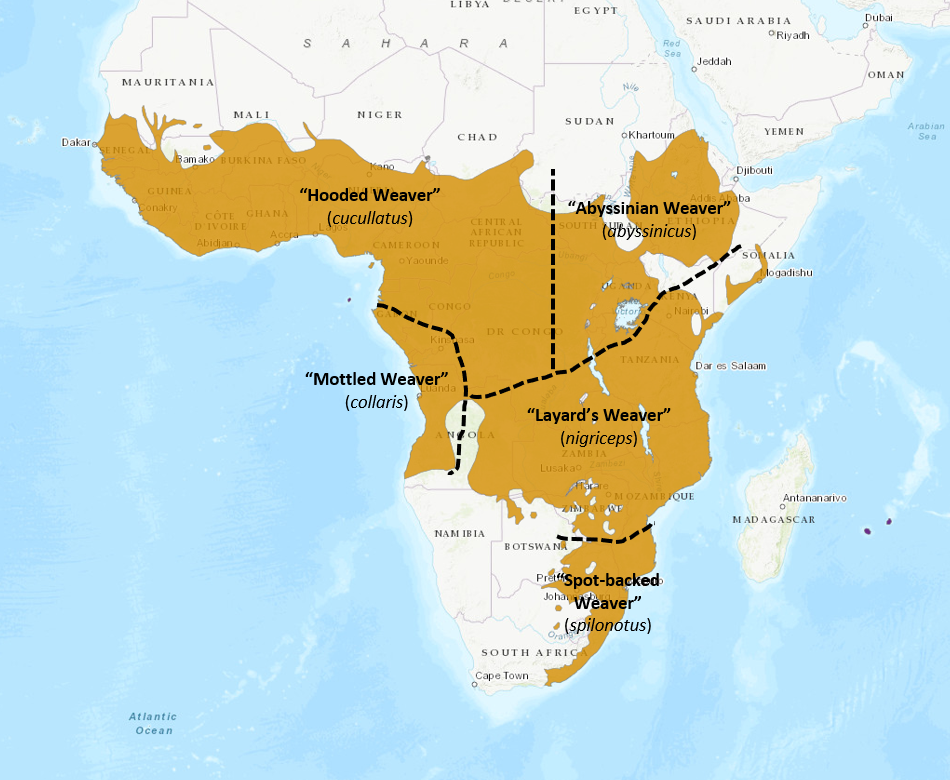
Approximate natural distributions of the forms of Village Weaver. © BirdLife International 2018
Resident in forests and savannas of the Sahel and tropical West Africa, north to southern Mauritania, central Mali, southern Niger, central Chad, the Central African Republic, and southwestern Sudan, and south to northern Gabon, the Congo Republic, and the central Democratic Republic of the Congo. Also resident on Bioko.
The full extent of its range in central Africa is not well-documented. In western Gabon, it occurs south at least to Libreville. In the interior of the D.R. Congo, the clearing of rain forest is likely enabling expansion of this and three other forms of Village Weaver (“Mottled” from the southwest, “Abyssinian” from the east, and “Layard’s” from the south), bringing them into contact with one another, with uncertain results.
Introduced populations are established and expanding in a few areas around the Caribbean. It was originally introduced to Hispaniola via vessels of the slave trade, and has long been widespread throughout the lowlands of Haiti and the Dominican Republic. A much smaller population on Martinique was apparently introduced around the early 1960s.
In northern Venezuela it occurs in several areas in the largely urbanized corridor from Barquisimeto to Caracas—especially in the Valencia-Maracay area. Small outpost populations have formed farther west in Maracaibo and Coro (coastal Falcón), and farther east in Sucre and Monagas. An additional outpost population in northwestern Trinidad (reported from the Caroni rice fields since 2014) apparently resulted from natural colonization from the mainland.
Identification
Like other forms of Village Weaver: a large, stocky, heavy-billed weaver with vivid red eyes, that is often found in agricultural and settled areas. The breeding male differs from similar forms in having extensive chestnut on its nape, bold black stripes on its back, and an orangish breast.
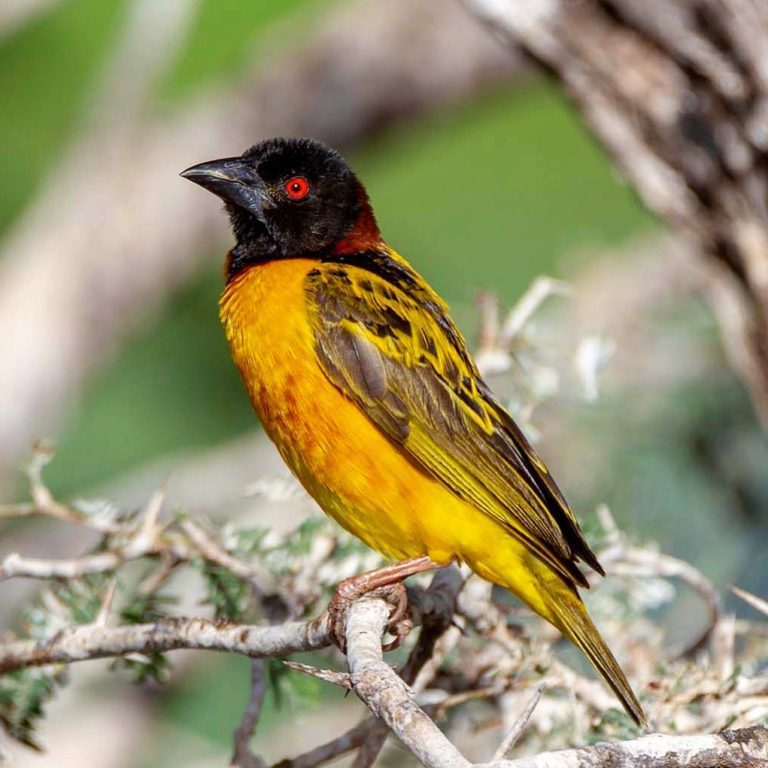
“Hooded Weaver”, T. c. cucullatus, male in breeding plumage. (Monte Cristi, Dominican Republic; June 14, 2019.) © Javier Gautier
Males in breeding plumage are yellow or orange overall, with a full black hood and a wide chestnut patch on the nape.
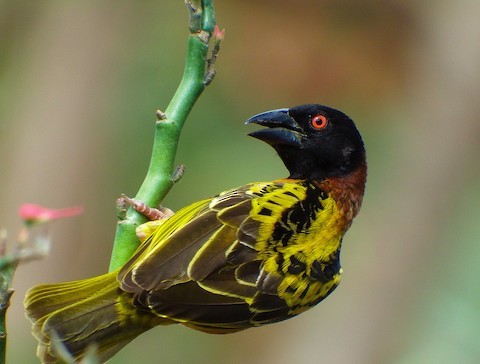
“Hooded Weaver”, T. c. cucullatus, male in breeding plumage, dorsal view showing bold black straps and chestnut nape. (Penjem, Gambia; July 1, 2015.) © Eildert Beeftink
The black of the hood projects down narrowly below the throat, narrowly bordered with chestnut, and the rest of the breast typically appears more orangish than yellow.
The back is yellow with two bold black “straps” or “braces” in a partial V pattern—also spotted on either side but mostly solid yellow in the middle. “Hooded” shares this basic pattern with the “Abyssinian Weaver” of East Africa.
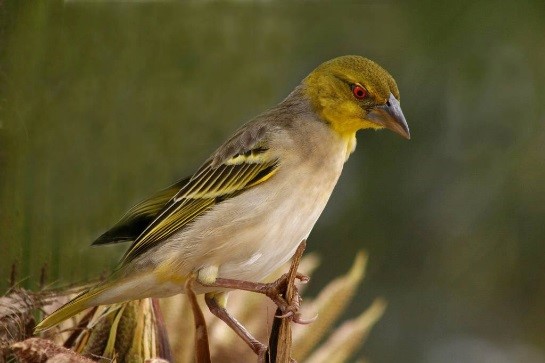
“Hooded Weaver”, T. c. cucullatus, basic plumage. (Marakissa, Gambia; February 2, 2007.) © Paul van Giersbergen
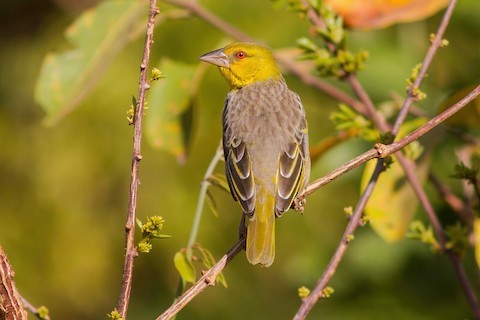
“Hooded Weaver”, T. c. cucullatus, basic plumage. (Forêt de Sangako, Toubacouta, Senegal; January 18, 2013.) © Yeray Seminario
As in other forms of Village Weaver, females, immatures, and nonbreeding males are comparatively drab and nondescript, but variable—often best recognized by their large bills and red eyes.

“Hooded Weaver”, T. c. cucullatus, basic plumage. (The Gambia; April 21, 2014.) © Stewart Burns
They can be either olive or grayish overall, variably suffused with pale lemon yellow, mainly on the head, throat, wings, and tail—often with a distinct yellow brow.

“Hooded Weaver”, T. c. cucullatus, basic plumage, showing that the red eye is not always apparent. (Bafatá, Guinea-Bissau; March 18, 2019.) © Antonio Xeira
As in several other weaver species, colonies are often dense clusters of nests that are noticeable at a distance. The nest is a roughly spherical woven mass that is suspended from a branch or palm frond, entered from below.

“Hooded Weaver”, T. c. cucullatus, colony with several males visible. (Hotel Bijagós, Ilha de Bubaque, Guinea-Bissau; March 5, 2022.) © Lutz Duerselen

“Hooded Weaver”, T. c. cucullatus, males weaving nests. (Nianing, Senegal; May 9, 2010.) © Jean-François Garin
Voice. Typical vocalizations are rapid torrents of variable chatter, consisting of clicks, buzzes, whistles, etc.: Sometimes calls slowly and deliberately, repeating a pattern of chuck notes and whistles:Flocks maintain a rich, noisy chatter of clucks, whistles, buzzes, and churs:
Notes
Monotypic form, one of five potentially distinct forms of Village Weaver (cucullatus). The name “Hooded” is not in general usage, but is a direct translation of the scientific name cucullatus.
See below for comparisons of the “Hooded Weaver” with the “Abyssinian” and “Mottled” Weavers.
Cf. “Abyssinian Weaver”. The “Hooded” and “Abyssinian” forms of Village Weaver are very similar. Males in breeding plumage differ in the amount of black on the head and in the pattern and coloration of the nape. Whereas “Hooded” has a complete hood, with an all-black head and a broad chestnut patch across the nape, “Abyssinian” has a mostly-black head with a chestnut border, and its nape is mostly yellow or orange.
Cf. “Mottled Weaver”. The “Hooded” and “Mottled” forms of Village Weaver are very similar and could potentially intergrade where their ranges approach one another in northwestern Gabon. Males in breeding plumage are similar because both have full black hoods. They differ in the coloration on the chest and nape, and in the pattern on their backs.
Chest: The breeding male “Hooded Weaver” typically has a narrow chestnut bib or border beside the black on its throat, whereas “Mottled” has a broad chestnut bib that covers a large portion of the chest.
Nape: The breeding male “Hooded Weaver” typically has a narrow chestnut band on the nape, whereas “Mottled” has a crisply defined black hood that contrasts with its back.
Back: The breeding male “Hooded Weaver” typically has a yellow back with broad black bars or patches on either side of it, whereas “Mottled” has a mostly yellow back with small black spots.
More Images of the “Hooded Weaver”

“Hooded Weaver”, T. c. cucullatus, male in breeding plumage, brighter-yellow than most. (Bana, Cameroon; August 11, 2019.) © Antoon de Vylder
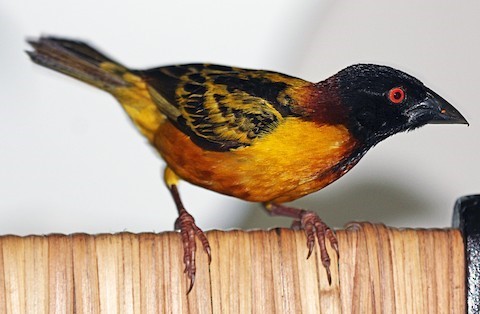
“Hooded Weaver”, T. c. cucullatus, male in breeding plumage, darker than most, perched on the back of a chair. (Kribi, Cameroon; January 5, 2011.) © Marco Valentini
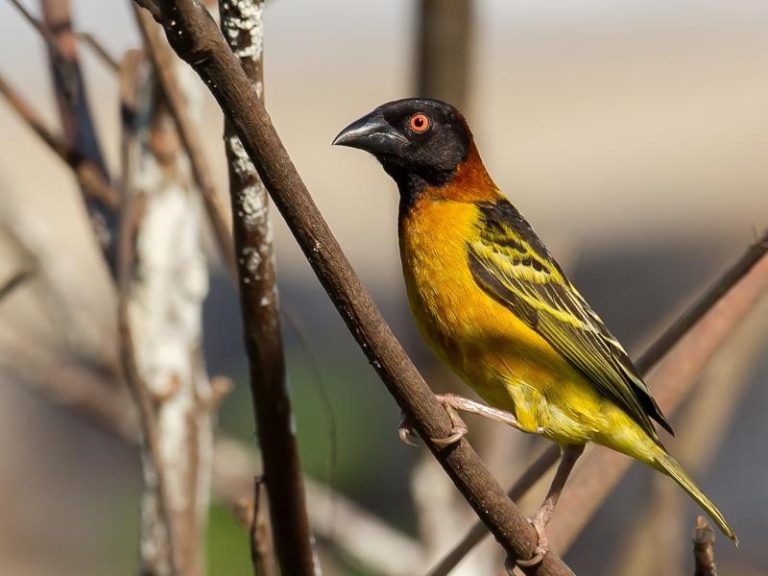
“Hooded Weaver”, T. c. cucullatus, male in breeding plumage. (Libreville, Gabon; September 19, 2013.) © Paul van Giersbergen
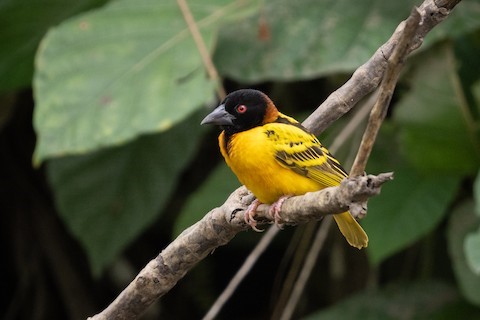
“Hooded Weaver”, T. c. cucullatus, male in breeding plumage. (Ebekawopa, Ghana; November 21, 2021.) © Simon Colenutt

“Hooded Weaver”, T. c. cucullatus, male weaving a nest. (Nianing, Senegal; May 9, 2010.) © Jean-François Garin
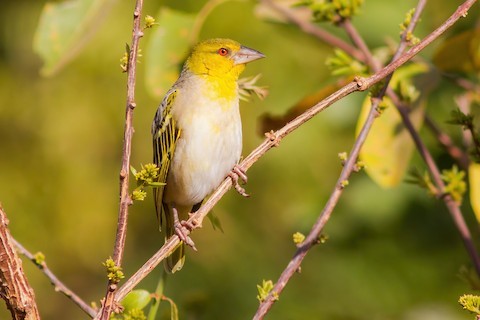
“Hooded Weaver”, T. c. cucullatus, basic plumage. (Forêt de Sangako, Toubacouta, Senegal; January 18, 2013.) © Yeray Seminario
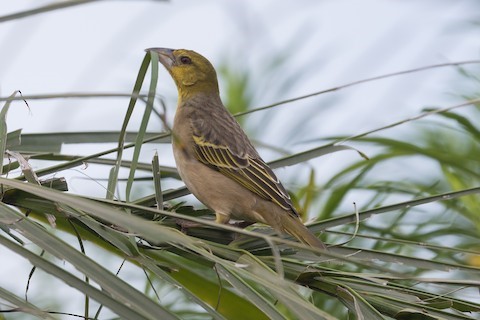
“Hooded Weaver”, T. c. cucullatus, basic plumage. (Janjanbureh, Gambia; January 4, 2019.) © James Kennerley
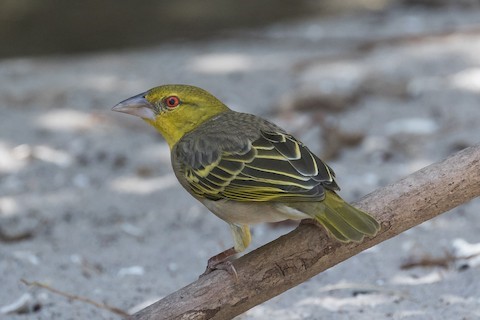
“Hooded Weaver”, T. c. cucullatus, basic plumage. (Kotu, Banjul, Gambia; January 9, 2019.) © Peter Kennerley
References
Ascanio, D., G.A. Rodriguez, and R. Restall. 2017. Birds of Venezuela. Christopher Helm, London.
BirdLife International. 2018. Ploceus cucullatus. The IUCN Red List of Threatened Species 2018: e.T22718921A132122615. https://dx.doi.org/10.2305/IUCN.UK.2018-2.RLTS.T22718921A132122615.en. (Accessed April 26, 2022.)
Borrow, N., and R. Demey. 2004. Birds of Western Africa. Princeton University Press.
eBird. 2022. eBird: An online database of bird distribution and abundance. Cornell Lab of Ornithology, Ithaca, N.Y. http://www.ebird.org. (Accessed April 26, 2022.)
Kirwan, G.M., A. Levesque, M. Oberle, and C.J. Sharpe. 2019. Birds of the West Indies. Lynx Edicions, Barcelona.
Latta, S., C. Rimmer, A. Keith, J. Wiley, H. Raffaele, K. McFarland, and E. Fernandez. 2006. Birds of the Dominican Republic and Haiti. Princeton University Press.
Raffaele, H., J. Wiley, O. Garrido, A. Keith, and J. Raffaele. 1998. A Guide to the Birds of the West Indies. Princeton University Press.
Sinclair, I., and P. Ryan. 2003. Birds of Africa South of the Sahara. Princeton University Press.
van Perlo, B. 2002. Birds of Western and Central Africa. Princeton University Press.
Xeno-Canto. 2022. Village Weaver – Ploceus cucullatus. https://xeno-canto.org/species/Ploceus-cucullatus. (Accessed April 26, 2022.)
